10 psychological experiments about human behavior that reveal the unpleasant truth about us
Categories: Health and Medicine
By Pictolic https://pictolic.com/article/10-psychological-experiments-about-human-behavior-that-reveal-the-unpleasant-truth-about-us.htmlMan has always been fascinated by the unknown nature of how the mind works and what causes our behavior. And at the beginning of the XX century, experimental psychology was developed.
The research explored a range of areas, from behavioral to social dynamics to the complex biological processes that occur in the brain. The results of carefully controlled research conducted in the name of experimental psychology have revealed a lot about the human condition, thanks to them we have a better understanding of why we behave in one way or another.
We have compiled a list of the most famous and intriguing experiments of the last century. From the simplest social models to those that study complex behavioral patterns that reveal how the human subconscious works and shift the accepted ethical framework. You will definitely think about whether you know everything about yourself and what a person is really capable of.
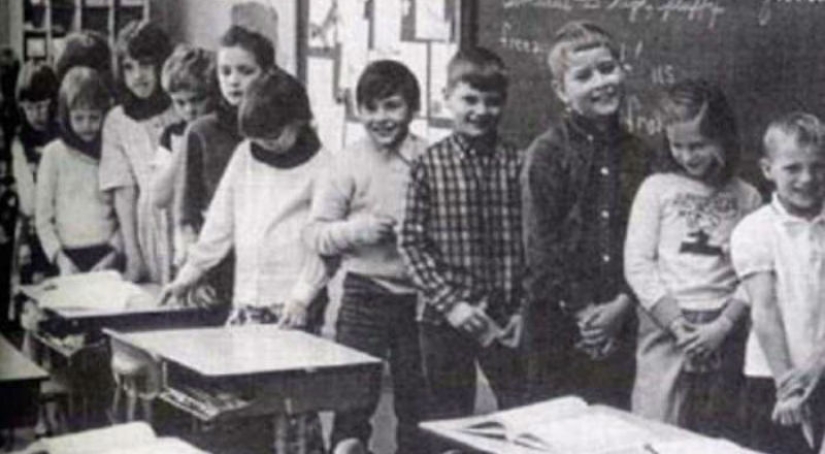
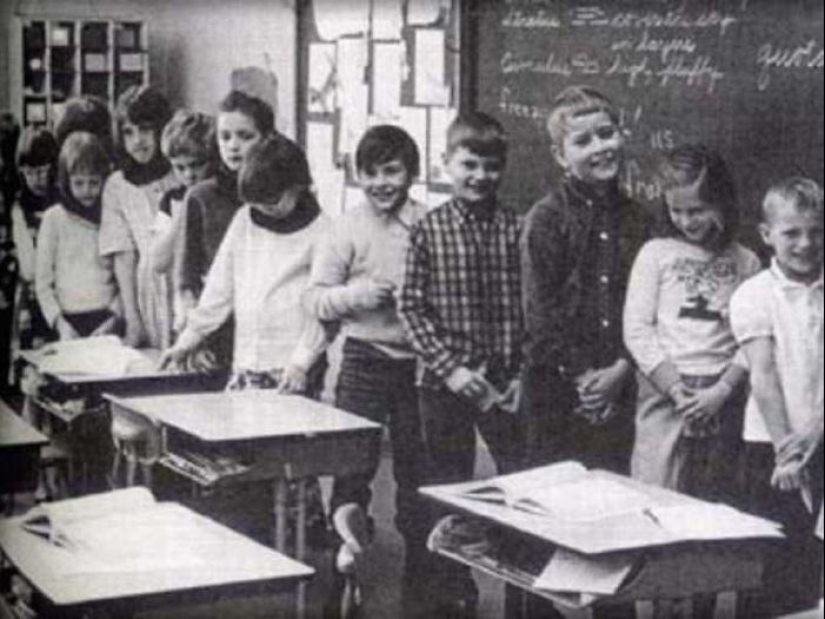
"Blue-eyed/brown-eyed»
In 1968, after the assassination of civil rights activist Martin Luther King, teacher Jane Elliott attempted to discuss discrimination, racism, and prejudice with third-grade students at a school in Riseville, Iowa. Sensing that children not only didn't understand what color discrimination meant, but had never experienced it in a small town, Elliot began a two-day "blue-eyed/brown-eyed" exercise to show the unfairness of racism.
The students were divided into two groups by eye color. The owners of blue eyes had privileges in the educational process: a second portion for lunch, access to the new game room, an extra five minutes at recess. Elliott placed the blue-eyed students in the front rows of the class, while the brown-eyed students were sent to the back rows. She motivated the students to communicate only with classmates from her group, advising them to avoid contact with brown-eyed students.
Also, representatives of the two groups were forbidden to drink water from the same fountain. Brown-eyed people were constantly punished by the teacher when they did not follow the rules or made some mistakes. Elliott emphasized the differences between the groups, highlighting the advantages of blue-eyed students and the disadvantages of brown-eyed students. The next day, the brown-eyed students became the privileged students.
As a result, the group that was considered superior became better at learning. Those who were discriminated against began to make more mistakes — even those students who were excellent students before the experiment.

Steps in the form of a piano
The Volkswagen initiative group called The Fun Theory ("The theory of fun») I wanted to prove that a person's behavior can change for the better if you add fun to routine and boring actions. They placed piano-shaped steps in the Stockholm metro to see how many people would choose a staircase instead of an escalator.
The results showed that 66 percent chose the stairs with musical steps that day.

The violinist in the subway
On January 12, 2007, about a thousand passengers passing through Metro station in Washington, DC in the morning heard a small free concert performed by virtuoso violinist Joshua Bell. He played for about 45 minutes, performing six classical pieces on a 1713 Stradivarius violin, which, according to some sources, is worth $ 3.5 million.
Only six people stopped to listen to the music. About 20 gave money, continuing to go at their usual pace. The violinist collected $ 32. When he finished playing and there was silence, no one noticed. No one applauded. No one realized that one of the best musicians in the world played one of the most complex compositions on a $ 3.5 million violin.
The Washington Post writer and journalist Gene Weingarten, the author of this experiment, described it "as an experiment about context, perception and priorities, as well as the assessment of public taste: in a banal and boring environment, at an inconvenient time for everyone, will beauty be noticeable?".

Smoke in the room
For the experiment, people were gathered in one room who were filling out a questionnaire when smoke suddenly poured out from under the door. What would you do? Most likely, they would have got up and left the room or reported it to the responsible person. Now imagine the same situation, except that you are not alone, there are still people with you who do not seem to be bothered by the smoke at all.
The two hired actors had to act as if nothing was happening. In the end, only 10% of the subjects left the room or reported smoke. 9 out of 10 actually continued to work on the questionnaire, rubbing their eyes and waving the smoke away from their faces.
The experiment showed that people react more slowly or do not respond at all to emergencies in the presence of passive personalities. We rely more on other people's reactions and behaviors than on our own instincts. If a group of people acts like everything is fine, then it must be, right? Not really. Do not allow yourself to be inactive because of the passivity of others. Do not think that someone else will always help.
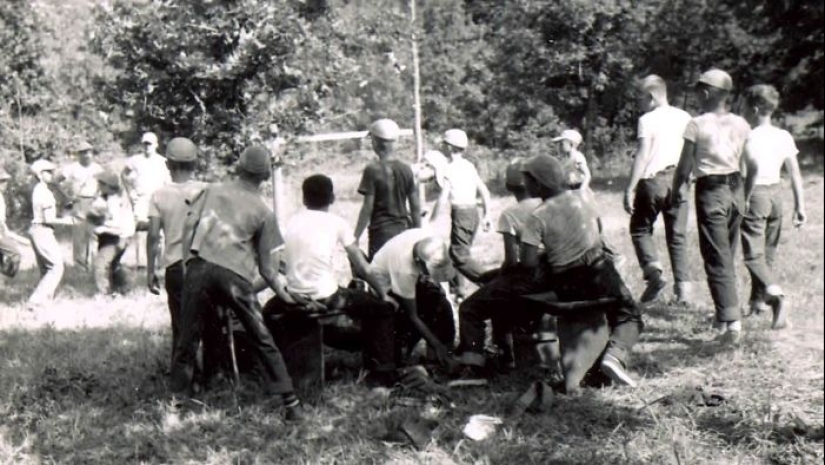
"Summer camp»
This experiment tested the theory of realistic conflicts and was an example of how negative attitudes arise between groups due to competition for limited resources.
The experimenters took two groups of 11-and 12-year-old boys and placed them in what they thought was a summer camp. For the first week, the groups were separated and didn't know about each other. During this time, relations within the groups have become stronger.
Then the boys were introduced to each other, and immediately signs of conflict began to appear. The experimenters created competition between the groups, and as expected, the level of hostility and aggressive behavior increased.
In the third week, the experimenters created conditions for both groups to work together to solve a common problem. For example, the problem of drinking water. The children had the impression that their drinking water was cut off, possibly due to vandals. Both groups worked together to solve this problem.
By the end of the experiment, after the boys from different groups worked together, they became friends, which indicates that working together is one of the most effective ways to reduce prejudice and discrimination.

The Carlsberg Experiment
The social experiment was conducted by the Danish brewery Carlsberg. An unsuspecting couple walked into a movie theater packed with bikers. There were only two seats available next to the tattooed biker.
According to the results of an unofficial experiment (it was conducted as an advertisement for the product), not all couples sat in empty seats: when they saw a neighbor, they immediately left the hall. Some still stayed and took a seat, for which they were immediately rewarded with applause and free Carlsberg beer. Don't judge a book by its cover.

The disinformation effect
In 1974, Elizabeth Loftus began to study the effect of disinformation on the example of road accidents. In one experiment, seven video sequences lasting from 5 to 30 seconds were shown to 45 students, divided into groups of 9 people. In these videos, there was a recording of a car accident. After each video, the students filled out a questionnaire, the first item in which was formulated as follows: "Give a report on the accident that you just saw."
Then a number of specific questions about road accidents were presented. The most important question concerned the speed of the cars shown in the video. Nine people were asked: "How fast were the cars moving in the video at the moment when they crashed into each other?" The rest of the subjects received a similar question, but instead of the word "crashed", the words "touched", "hit", "crashed", "bumped"were used. When using the word "crashed" in the question, the cars were assigned the highest speed — 40.8 mph. The result of this experiment was the conclusion that the form of the question affects the response of the witness. Loftus made the assumption that this is due to changes in the representation in the memory of the subjects.
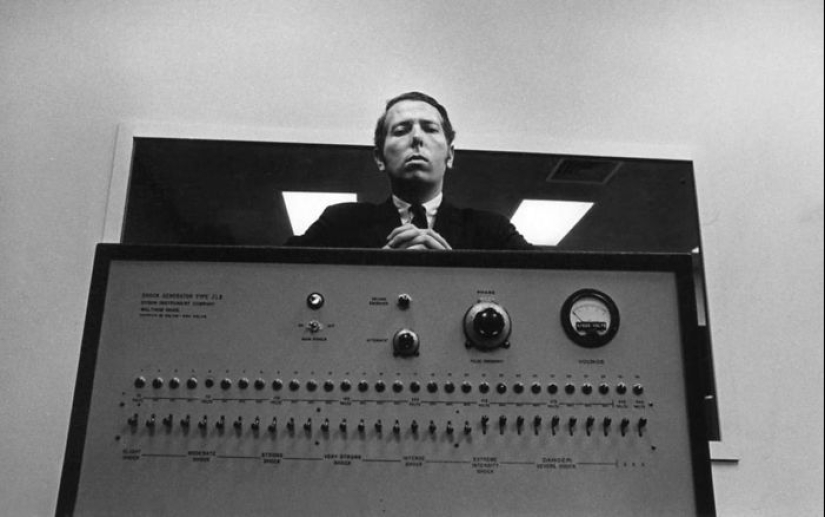
The Milgram Experiment
This experiment was conducted in 1961 by psychologist Stanley Milgram. His goal was to understand how far people can go in obeying authorities, even if orders from these authorities harm other people.
The experiment involved an experimenter, a subject, and an actor playing the role of another subject. It was stated that one of the participants (the"student") should memorize pairs of words from a long list until he remembers each pair, and the other (the"teacher") should test the memory of the first and punish him for each mistake with an increasingly strong electric discharge.
At the beginning of the experiment, the roles of teacher and student were distributed between the subject and the actor "by lot" using folded sheets of paper with the words "teacher" and "student", and the subject always got the role of teacher. After that ,the" student " was ostentatiously tied to a chair with electrodes. The "teacher" received a "demonstration" electric shock.
The "teacher" would go into another room and sit down at the table in front of the generator. The experimenter explains to the "teacher" that when each of the switches is pressed, the corresponding voltage is applied to the student, and when the switch is released, the current action stops. The pressed switch remains in the lower position, so that the "teacher" does not forget which switch was already pressed and which was not. The device gave a serious impression of the real one, giving no reason to doubt the authenticity of the experiment.
No one was actually electrocuted. The "student" deliberately answered the questions incorrectly and pretended that it was getting more painful, as the tension allegedly increased with each incorrect answer. Despite this, many subjects continued to electrocute people when ordered by the authority-the "experimenter". In the end, 65% of the subjects used such an "electric shock", which could be fatal.
The results of the experiment showed that ordinary people are more likely to follow orders from an authoritative figure, even to the point of killing an innocent person. Submission to authority is ingrained in all of us, because this is how we are raised as children.
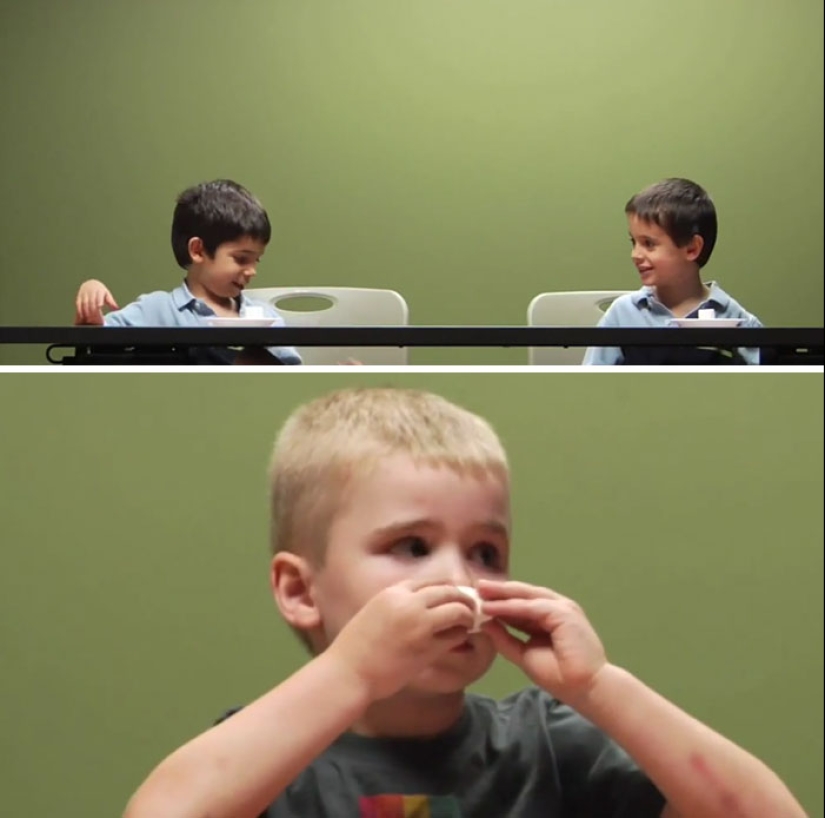
Marshmallow Test
An experiment in the late 1960s and early 1970s, led by psychologist Walter Michel, included a series of studies on the topic of deferred reward.
Children from 4 to 6 years old were put on a chair in a room where there was a treat on the table (most often marshmallows, sometimes cookies or pretzels). The children were told that they could eat sweets, but if they waited 15 minutes and did not give in to the temptation, they would get a second portion.
Michel noticed that some people covered their eyes with their hands or turned so that they could not see the sweets, while others started kicking the table, pulling their hair, or stroking the marshmallow as if it were a stuffed toy. Others simply ate the marshmallows as soon as the researchers left.
More than 600 children took part in the experiment. The minority immediately ate the treat. Of those who tried to hold on, one-third received a second treat. And age was the main determining factor.
Further research showed that children who were able to wait tended to have better life outcomes, higher educational attainment, and a lower body mass index.

False consensus effect
In this experiment, the researchers asked college students if they would walk around campus for half an hour with a large sign saying, " Eat at Joe's."
The students were then asked to estimate how many people would agree to this. As a result, those who agreed to walk with the sign suggested that most people would also agree. Those who refused naturally thought that the majority would refuse just like them. That is, the study participants firmly believed that most people would make the same choices they did.
The results demonstrated what is known in psychology as the false consensus effect. No matter what our beliefs, opinions, or behaviors are, we tend to believe that most other people agree with us and act the same way we do.
Keywords: Health and medicine | Man | Experiment | Mind | Psychology | Behavior
Post News ArticleRecent articles

A wrinkled forehead, a toothless mouth, frowning brows or, conversely, a happy smile and the absence of hair or their rare ...

Have you ever wondered what is the oldest name on the planet? No, we don't mean Adam and Eve, which the Bible mentions. We are ...
Related articles

One of the tallest people in the world is now fighting for life in a London orphanage. The height of Hussein Bisad is 2.32 m. A ...

While the Red Army used the "front-line hundred grams", methamphetamines were used on the other side of the trenches. Under the ...

In 2019, a resident of the United Arab Emirates, Munira Abdullah, regained consciousness in a private clinic in Germany after 27 ...

It's sad to say, but we're all going to die. Death comes into the life of any person, and often unexpectedly. However, there are ...